Daimlerstrasse 38 or How to get a fox to shoot portrait of itself
Posted in: Uncategorized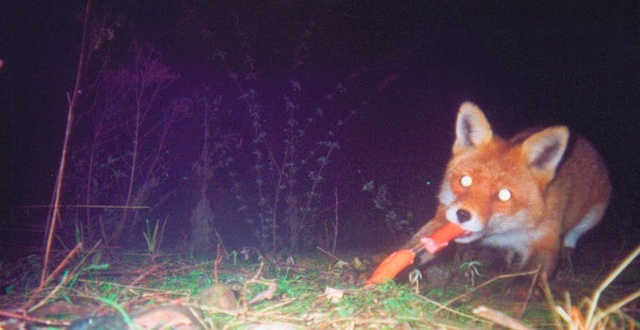

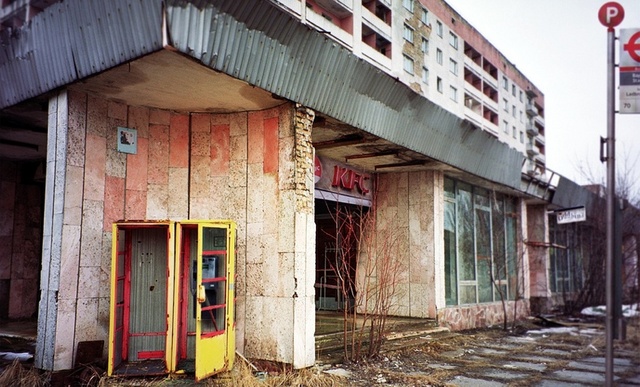
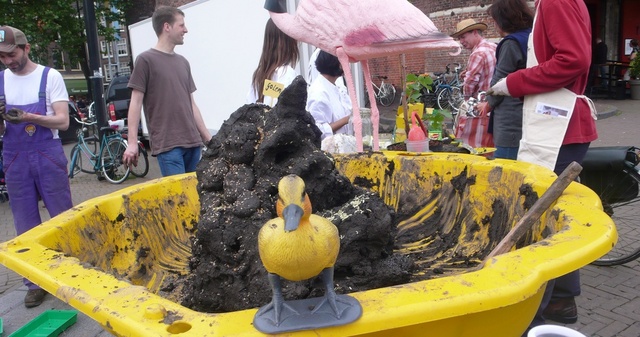

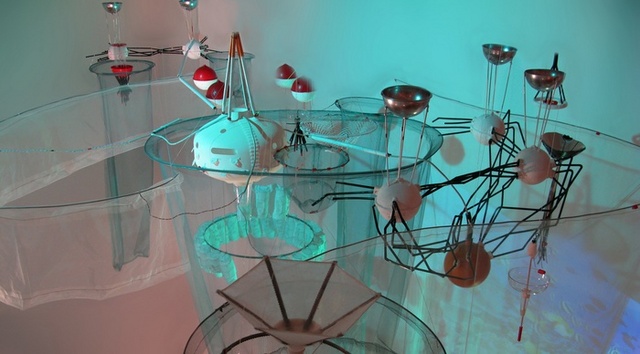
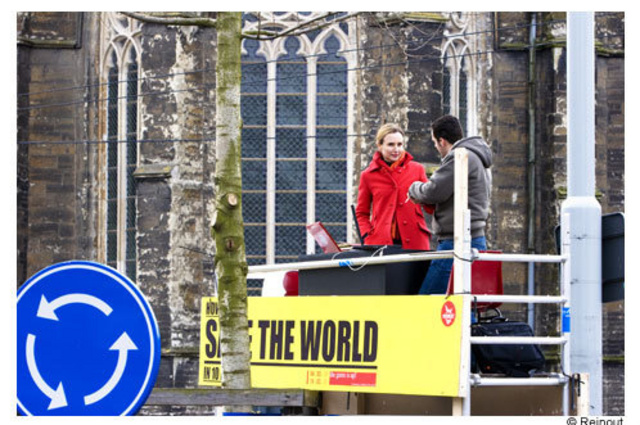
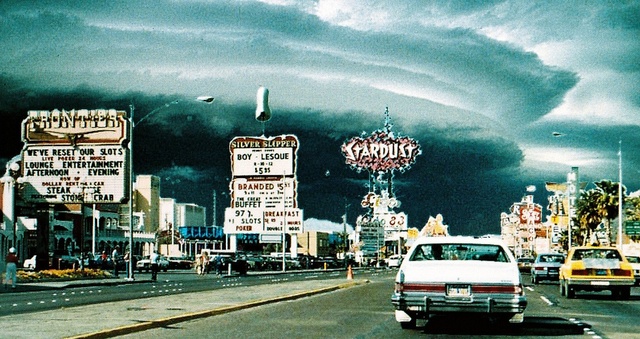
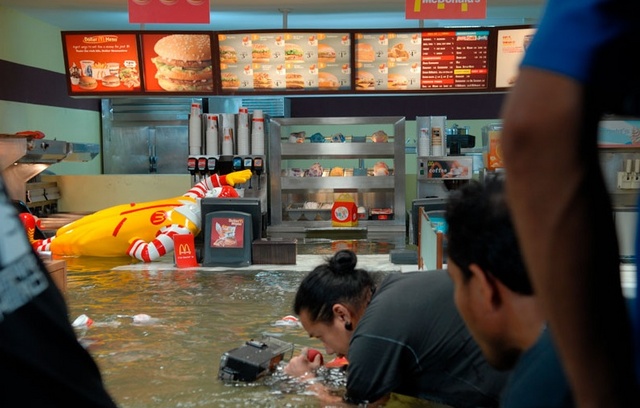
Another project from the RCA Design Interactions show. This one made me laugh so much:
In wealthier neighbourhoods, the size of the house and how well maintained the garden is, often represents status.
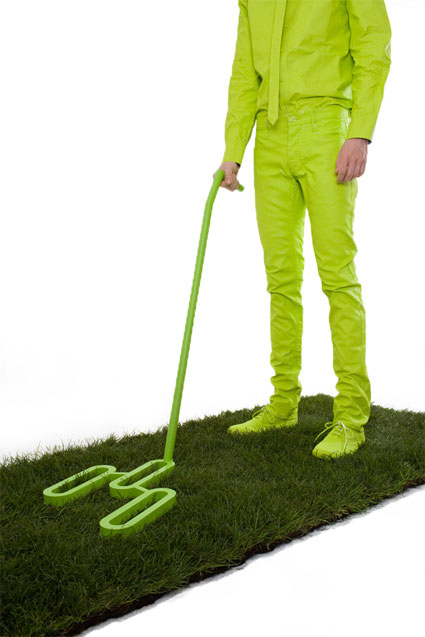
The Grass Scanner is a device designed by Alice Wang to measure how green the grass is. Using 3 Pantone Color Cue devices, it takes reading from 3 random patches of the grass and outputs a Pantone colour code for one to compare. With the codes, one can refer to the PARKTONE cards which contains average grass colours of Royal Parks and other green areas in the UK for people to match up with their own garden.
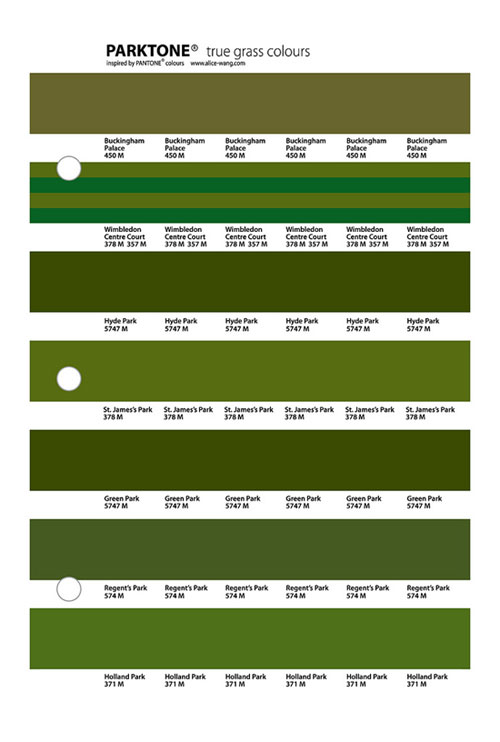
As grass condition in different areas of a given park may vary, each area was measured several times before an average of the data was used to create the PARKTONE card.
Relate: Mugs for a perfect tea.
Back in July, while i was visiting Documenta 12 in Kassel, i saw a 16-metre-long flower-bed raised above the ground, with 70 packets of seeds sprouting from the grass, each of them carrying worrying labels that documented the latest form of Colonialism: biopiracy.
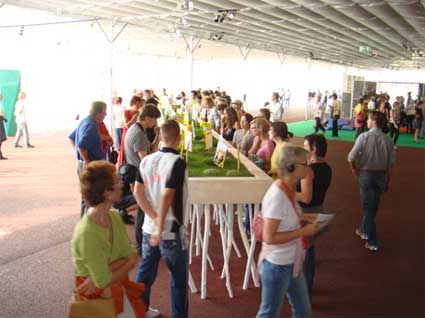
Photo documenta 12
Biopiracy describes a new form of “colonial pillaging” in which western corporations reap profits by taking out patents on indigenous plants, food, local knowledge, human tissues and drugs from developing countries and turning them into lucrative products. Only in few cases are the benefits shared with the country of origin.
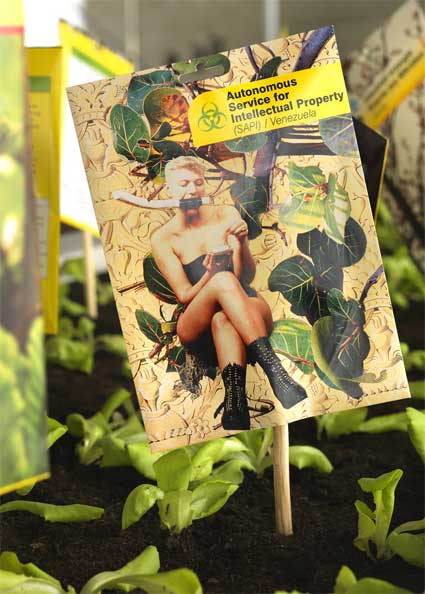
Biopiracy targets particularly countries known for their exceptionally high level of cultural and biological variety: Mexico, India, Brazil, Indonesia and Australia. This process is also referred to as “internal conquest” in analogy to the “external conquest” of colonialism.
In her Siegesgärten (Victory gardens, 2007) installation, Vienna artist Ines Doujak criticized the bio-politics of EU and the USA which turn a blind eye on the ruthless economization of nature and of life. The seed packets sprouting from the flower-bed informed visitors about global exploitation, genetic engineering and monoculture. On the front of the packets are photo-collages showing drag queens and kings and fetish secual practices set in exotic natural settings. On the back, the conditions and consequences of biopiracy are described and illustrated using real examples of the practice.
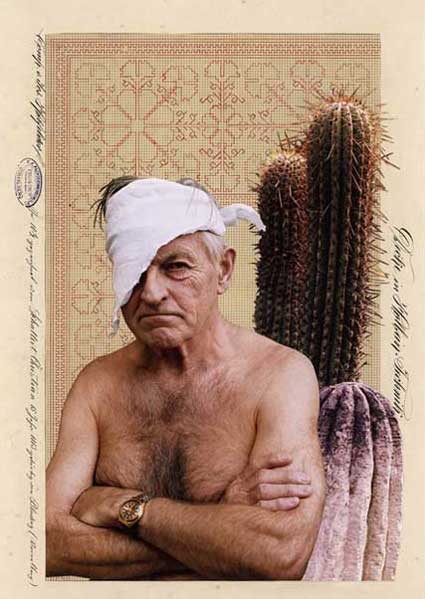
“We fear an increasing dependency on large corporations that seek to control global food production and agriculture by means of patents, from milk to bread and from baking grains to energy plants”, explained patent expert Christoph Then (via no patents on seeds.)
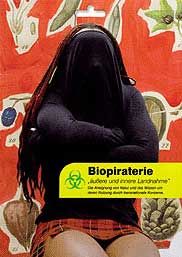
I had kept the artwork somewhere in the back of my mind, feeling that i needed to investigate the matter deeper. Now, Doujak has collected the images and texts relating to her work in a book which is partly in german and partly in english.
This is an eye-opening book (at least for me). I don’t think i’ll ever shop the same way again. Except that it’s not going to be easy. I can boycott a few cosmetics but how could i live without the giant which has been accused of being the “biggest threat to genetic privacy” for its alleged plan to create a searchable database of genetic information: Google? In her book, Doujak retraces many cases of biopiracy, while giving a context for the practice.
In 1980, Ananda Chakrabarty became the first person to receive a patent for a transgenic organism, a bacterium he had engineered to digest oil. Previously, life forms had been excluded from patent laws. The landmark patent has since paved the way for many others on genetically modified micro-organisms and other life forms.
5 years later, the U.S. Patent and Trademark Office allowed GM plants, seeds and plant tissues to be patented. And by 1987 animal patenting followed. Today even human gene sequences, cell lines and stem cells are permitted. Corporate interests can thus corner life forms for the lifetime of a patent and have a monopoly on their exploitation. With the advent of nanotechnology comes the rise of what the Captain Hook Awards call the nanopirates, those who claim ownership of the molecules and even the elements that everything is made from.
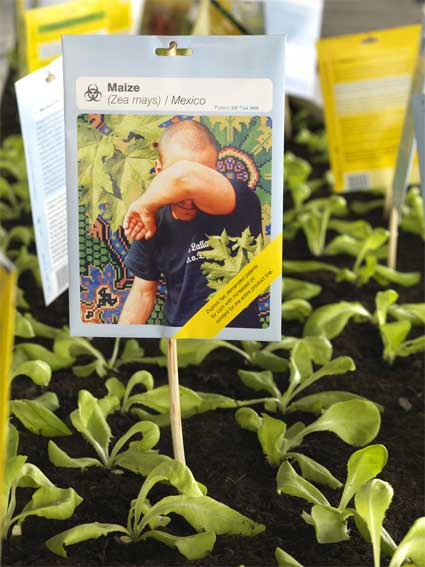
Image documenta 12
As Ines Doujak writes in the book:
The stories collected by the artists are fearsome, here’s just a couple of them:
– Genetic material from members of some indigenous communities in Brazil and Venezuela can be purchased for 85 dollars through the Internet. It is unclear whether the samples were obtained with the full and informed consent of the individuals and of the Brazilian government. Another issue is whether there are guarantees in place to ensure equitable distribution of the knowledge and profits generated from the samples.
– A coalition of indigenous farmers in Peru protests against the multinational corporation Syngenta’s patent for ‘terminator technology’ potatoes. The patent involves a genetic-modification process that ‘switch off’ seed fertility, and can therefore prevent farmers from using, storing and sharing seeds and storage organs such as potato tubers. The Indigenous Coalition Against Biopiracy in the Andes says that by commercialising such potatoes, the corporation would threaten more than 3,000 local potato varieties that form the basis of livelihoods and culture for millions of poor people. They also fear that pollen from the modified potatoes could contaminate local varieties and prevent their tubers from sprouting.
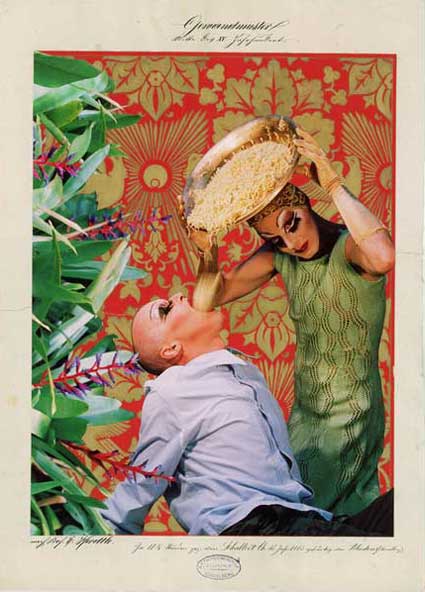
Some of the cases described in the book are comforting, they show how organized action can reverse unfair processes. That’s what happened with quinoa, a plant cultivated in the Andes for 6000 years. In 1994, scientists from Colorado University were granted a patent to a Bolivian species. This means they could also control the rights to any hybrids created using the Apelawa variety, including many traditional varieties grown by peasant farmers in Bolivia, Peru, Ecuador and Chile as well as varieties important in Bolivia’s quinoa export market.
As the president of the Bolivian National Association of Quinoa Producers said at the time: “Our intellectual integrity has been violated by this patent,” he said, “Quinoa has been developed by the Andean agriculturists for millennia, it wasn’t ‘invented’ by researchers in North America.” Protests proved successful: the patent was dropped in 1998.
A second case with annulment of a questionable patent concerns the Hagahai people (Papua New Guinea). Their first contact with the outside world was in 1984. Viruses and illnesses resulted in this contact decimated the Hagahai to such extent that they were under threat of extinction. Foreign researchers administered the vaccination needed but also took some DNA samples (without their knowledge). They discovered that the people is immune to leukaemia and degenerative neurological illnesses. The genetic qualities of the Hagahai were patented in the United States. Worldwide protests led to the annulment of the patent.
More images
from her work at documenta, Kassel.
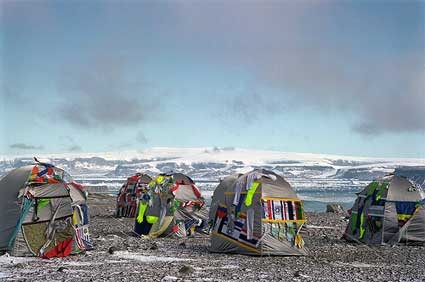
Lucy + Jorge Orta | Antarctic Village – No Borders, 2007, courtesy Galleria Continua, San Gimignano – Beijing. Photo: JJ Crance
According to the Antarctic Treaty signed in 1959, the continent’s territory is a protected ecosystem and as such cannot be used neither for military purposes nor commercial exploitation. The Antarctic contains 70% of the planet’s fresh water reserves in the form of ice and, today, its name evokes the slow melting of the ice caused by global warming. In 2007 Lucy + Jorge Orta went to the inhospitable land on an artistic and social research expedition.
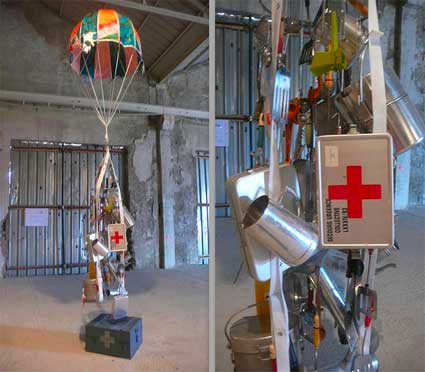
Antarctic Village – No Borders, Drop Parachute
The tents, survival kits, videos and mobile aid units created by the artists as a result of their expedition to the edge of the world are having their first public showing at the Hangar Bicocca in Milan. Hangar Bicocca is real big. Before being a space dedicated to contemporary art, it was a vast industrial factory that manufactured bobbins for electric train motors.
The star of the exhibition is Antarctic Village. Made of 50 dwellings that bring out the images of refugee camps broadcast on tv, the installation is a symbol of the plight of those struggling to cross borders and to gain the freedom of movement necessary to escape political and social conflict. The temporary encampment was envisioned as a free, neutral territory in a place where living conditions are so extreme that it imposes a situation of mutual aid and solidarity, no matter your nationality.
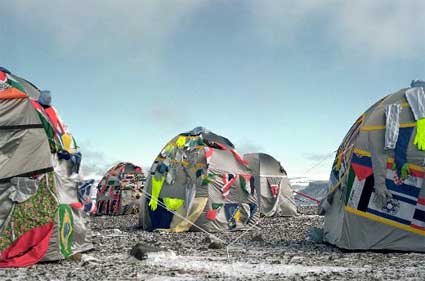
The tents are hand stitched with sections of flags from around the world, along with clothes and gloves, symbolising the multiplicity and diversity of people. A recent UN source states that 2.2 million migrants, mainly from the African and Asian continents, will arrive in the rich world every year from now until 2050. The artists go beyond their comment on the free circulation of individuals across the whole planet by proposing an amendment to the Universal Declaration of Human Right that would include the right to free circulation, on par with merchandise, economic flows and pollution.
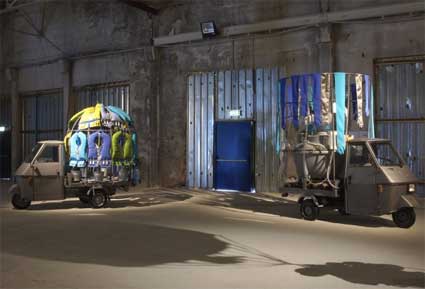
Photo Credit: Thierry Bal Photography
The Antarctica exhibition is also an occasion for presenting other works created by the couple over the last five years, addressing social, environmental and humanitarian issues: mobility, migration, climate and environmental crises, and human rights:
– Orta Water, everyday objects and mobile prototypes which allow for water gathering, purification and distribution. They were designed for the part of the world population whose access to food and water is put at risk by the consequences of environmental crisis and free market privatization.
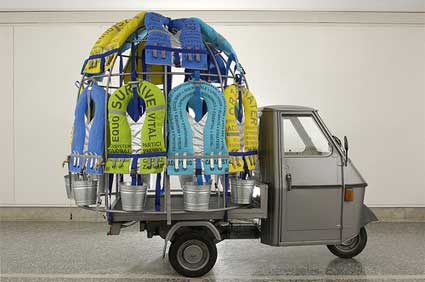
Orta Water – Urban intervention unit, 2005. Credit Photo, Gino Gabrielli
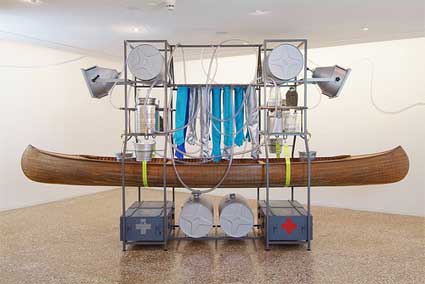
Orta Water – Mobile intervention unit. Photo credit: Gino Gabrieli
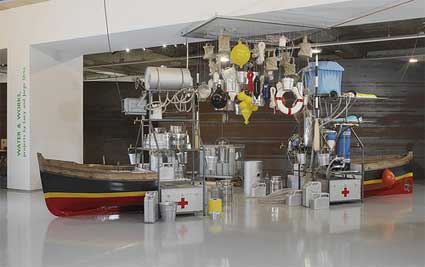
Orta Water – Purification station. Photo credit: Bob Goedewaagen
– Urban Life Guard, the famous series of survival figures created by the artists for their urban performances. The structure is made of stretchers, camp beds, resistant garments and modular devices, which, in case of situation of crisis or danger, can be assembled and used as sleeping bags or shelters.
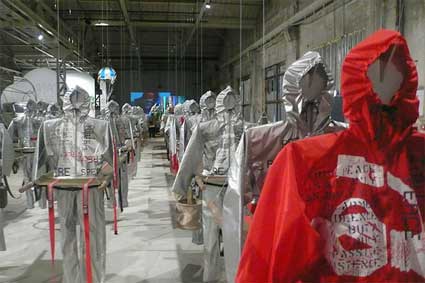
– some M.I.U. (Mobile Intervention Unit): industrial, ex-army vehicles or ambulances converted into first aid units for civilian populations. They are outfitted with an array of emergency equipment that range from water filtering systems to temporary dormitories. On the exterior, quotations, sentences or images recall the fate of those who are forced to immigrate for survival. Stationed at hangar Bicocca was Nomad Hotel, a reconditioned military four-wheel truck with micro living quarters and a transformed Red Cross ambulance, from which visitors can claim their Antarctic World Passport, created by the artists to offer a symbolic access to all the countries in the world.
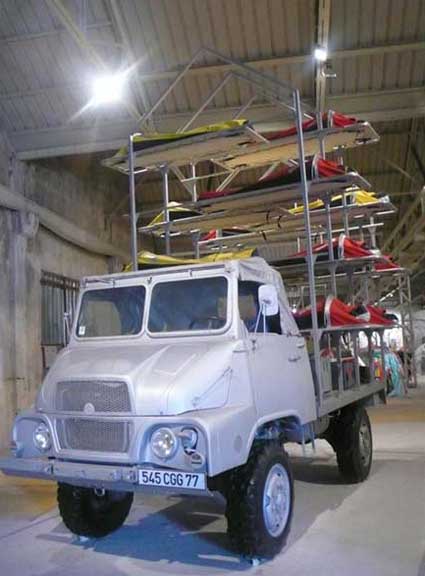
M.I.U. VII – Nomad Hotel, 2003
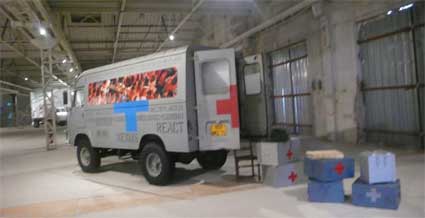
M.I.U. (Mobile Intervention Unit) ambulance
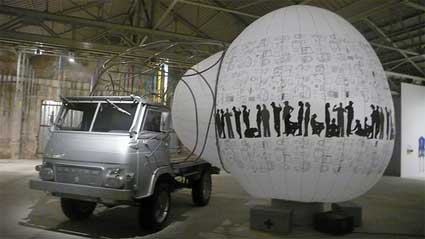
Dwelling X
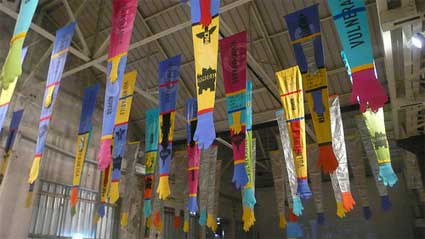
Ornaments of Suffering, 2005
Among the new works which have been commissioned for the Milan exhibition is a fascinating and poetic wall installation of life jackets Life Line.
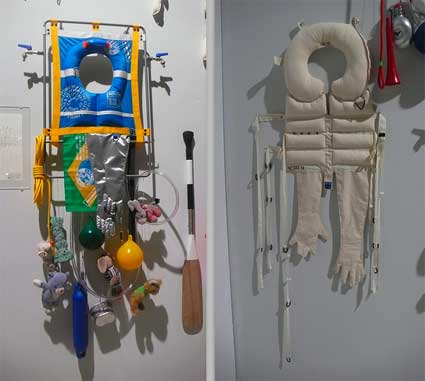
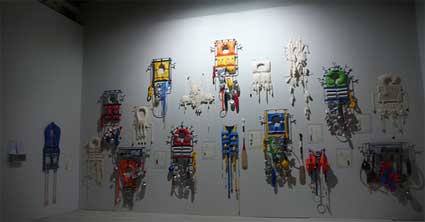
Lucy + Jorge Orta | Life Life – Survival Kit, 2008
My flickr set.
Lucy + Jorge Orta’s Antarctica expedition is on view at Hangar Bicocca in Milan until June 8, 2008.
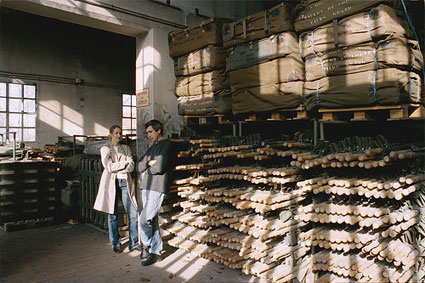
Portrait of Lucy and Jorge Orta
I know this isn’t anything earth-shatteringly new, but this outdoor from London a pretty cool installation piece in my mind, particularly given the timeliness of Earth Day.

While real plants (instead of plastic) would have been awesome (and more “green”), the faux plants probably make it leagues easier to actually put up. Interesting, visual, and simple. Seems appropriate as we wrap up Earth-centric festivities.
[via 30gms]
Today people will look down on you if your art space doesn’t have an exhibition dedicated to ecological issues on its agenda. Unsurprisingly, Milan still hasn’t organized anything worth mentioning but her little neighbour, the enlightened and chilly Turin, did. The show is called Greenwashing. Environment, Perils, Promises and Perplexities and is on view at the Fondazione Rebaudengo until May 11, 2008.
Here’s the premise: The diverse practices represented in the exhibition do not just point the finger at the degradation of our planet, they also make more tangible the contradictions and responsibilities that we encounter personally and as a society. Art here does not necessarily proclaim a ‘correct’ ethical or green choice, but allows the possibility for broadening and analysing our perceptions and actions.

Ettore Favini, Green is the Color of Money, 2007
The 25 artists and groups selected not only engage with emissions’ offsetting, food miles, environmental marketing, ecological footprints, and other eco-conscious issues but they also bring attention to their political and social consequences. Many of the works selected are extremely good at making environmental issues less abstract and remote from our daily reach. I’m glad i had the opportunity to see all these pieces in one go. That’s what thematic exhibitions are for, right? However, i couldn’t see much past the simple gathering of works, they have this environmental streak to keep them together but there is something missing in the curatorial vision. I don’t know the secret to curating an exhibition with a scope and breath which will go beyond the sum of all the works it gangs around but it sure is puzzling when the multiplier symbol is missing.
Still, this exhibition provides enough food for thought for people who are naive enough to believe that they can sleep soundly in their organic cotton bed linen just because they recycle glass, never print any paper unless they have no other choice and always bring their own bags to the supermarket.
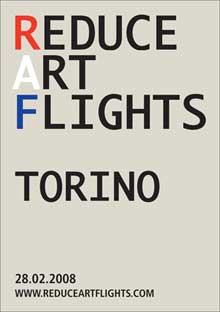 I, for one, can say proudly that i only drive bikes (i don’t have a driving license anyway) but when i saw the posters of RAF / Reduce Art Flights i could only laugh out loud at my own candor. I might not own a Hummer but i take an awful lot of planes for my work.
I, for one, can say proudly that i only drive bikes (i don’t have a driving license anyway) but when i saw the posters of RAF / Reduce Art Flights i could only laugh out loud at my own candor. I might not own a Hummer but i take an awful lot of planes for my work.
Initiated by Gustav Metzger, the RAF campaign upholds that the art world – artists, curators, critics, gallerists, collectors, museum directors, and art bloggers too i guess – could or should swap planes for less carbon dioxide-emitting transports.
The RAF acronym deliberately echoes the Royal Air Force – the aerial warfare branch of the British military – as well as the militant left-wing group known as the Red Army Faction. The message is communicated by mass-produced leaflets first distributed during Sculpture Projects M??nster last Summer. The Turin version of the leaflet is available in art galleries and inserted into international mailings in connection with the exhibition.
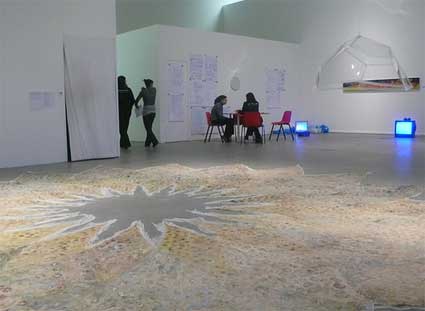
View of Beyond Pastoral (Shroud of Turin) at the Rebaudengo
BP’s environmental record is pretty appalling. In 2000, British Petroleum changed its name to BP (Beyond Petroleum) and chose a yellow and green sunflower-like as its logo in a bid to highlight its interest in alternative and environmentally friendly fuels. Nevertheless BP was named one of the “ten worst corporations” in both 2001 and 2005 based on its environmental and human rights records.
The Bruce High Quality Foundation‘s installation Beyond Pastoral (Shroud of Turin) grows out of a project that the BHQF initiated for an exhibition in New York in 2007, which consisted of a 1/5 scale model of the BP petrol station located opposite the gallery, underneath which thousands of lemons and limes were arranged in the form of the BP logo.
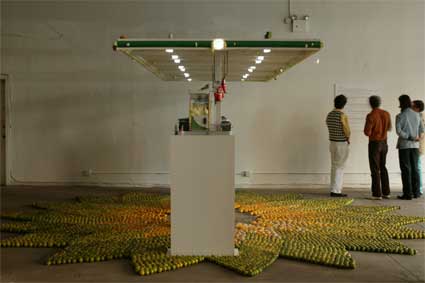
Installation in New York. Photo Oto Gillen
Each fruit was wired with electrodes and together they generated enough electrical current to illuminate the model. The irony of this seemingly earnest demonstration of an alternative energy source lies in the fact that the citruses quickly started to rot, posing a health hazard. Besides, transporting the fruit had required hundreds of liters of fuel. The Turin version of the work presented only the beautifully parched carpet of lemons and videos documenting the New York installation.
A few weeks ago, i was in a museum bar in New York and almost fell of my chair when i was served a bottle of San Pellegrino, a water that (i think) comes from Lombardy in Italy. Minerva Cuevas‘s installation in Turin echoes our absurd and eco-damaging fetishism for “exotic” waters.
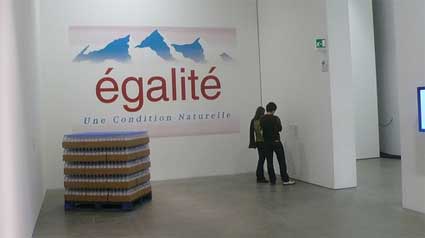
??galit?? (2003) also involves the sabotaging of a corporate graphic identity. Owned by the Danone group, Evian is probably the world’s best-known bottled water. Considering that the global market for bottled water multiplied more than 1000 times in the last decade – its average price is more than that of petrol – Cuevas has kept the shape and design of the bottle intact. Bar one detail: she replaced the familiar brand’s lettering by ??galit??, as in France’s motto, ‘Libert??, ??galit??, fraternit??’ (Liberty, equality, fraternity), subtly pointing out political issues linked to water throughout the world nowadays.
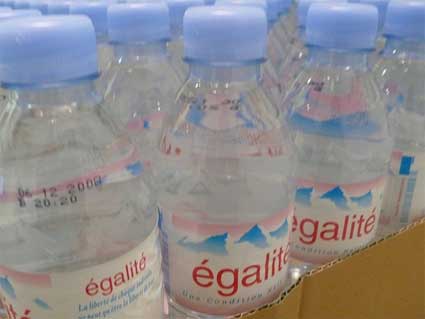
There is little equality as far as access to water is concerned, and those who have a seemingly unlimited access to it would rather pay ridiculous prices for something that comes almost freely from a tap.
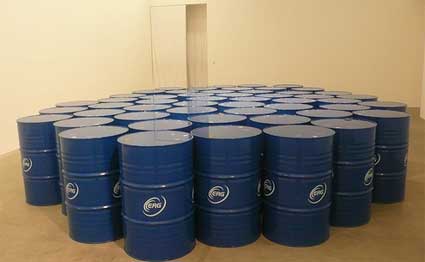
Wilfredo Prieto‘s Estanque installation is a congregation of crude oil barrels choreographed to look like an idyllic lily pond habitat complete with water puddles and a live frog (which had left the building when i visited the show).
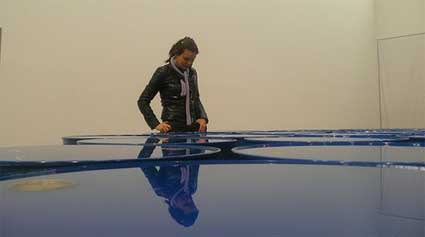
I’m the little frog on the oil pond!
Petroleum oil, which is itself an organic substance, is converted by the sheer iconic power of its container into a symbol of all of the ills of our fossil-fuel dependency. Yet the sculpture inevitably suggests the prospect of eco-advertising, as if its graphic visual summary of apparent amphibian-petroleum harmony could perfectly lend itself to an audacious company marketing department in a bid to demonstrate their ‘green’ industrial principles.
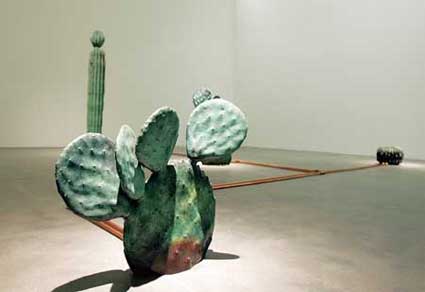
Simon Starling‘s ironic C.A.M. Crassulacean Acid Metabolism belongs to the artist’s fascinating series of “cactus works.” This installation is made of functioning cast iron radiators shaped like cacti and connected to a boiler with copper piping. The title of the work comes from a biochemical pathway that is a complex variation of photosynthesis, whereby some plants acquire carbon dioxide during the hours of darkness, minimizing thus eco-physiological stress and water loss from their leaves by avoiding gas exchange during the hot part of the day. C.A.M. opposes the supremely efficient and economical cactus strategy with the slightly ludicrous man-made radiators that expel heat into the exhibition space.
Jennifer Allora and Guillermo Calzadilla, whose life-sized clay hippopotamus had charmed me so much at the Venice Biennale in 2005, presented photos that document a participatory performance event they staged on the island of Vieques in March 2003 together with local residents and activist groups protesting against the U.S Military occupation of the island. The U.S had bought the land from the Puerto Rican government and had been using it for military exercises, and as a firing range and testing ground for bombs, missiles, and other weapons. The military experiments brought together with them severe ecological damage.
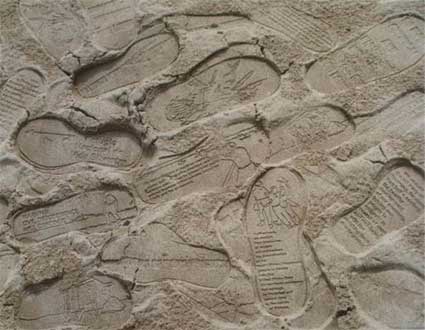
Jennifer Allora & Guillermo Calzadilla, Land Mark (Foot prints) #2, Set II, 2001-2004
Allora & Calzadilla designed rubber shoe soles to be worn during actions of protest. When activists illegally entered the bombing range, they left behind indented messages for the US military staff. The imprints were a way of reclaiming the disputed territory, giving new power to the term “landmark.”
Today the contested territory, though still contaminated and debated, is a wildlife reserve under the protection of the US Fish and Wildlife Service.
Verdict: Greenwashing is a moving exhibition worth taking the train for if you ever come to Milan this month for the Salone del Mobile. I’m sure there will be some inspiring projects and gadgets presented this year at the international furniture fair. I wonder if any of them will have the strength of most of the artworks i discovered at the Fondazione Rebaudengo the other day.
I went camera-crazy again.
GREENWASHING will run at the Fondazione Sandretto Re Rebaudengo centre for contemporary art in Turin, Italy through 11 May 2008.
Related: Book review: Worldchanging: A Users Guide for the 21st Century; Ecological Strategies in Today’s Art (part 1 and 2).
Previously at the Fondazione Re Rebaudengo: Murakami exhibition in Turin.
Image on the homepage: Amy Balkin, Public Smog, 2004.
The reason for my presence at etech08 this year was the “art fest” that i set up with the super nice and super smart Kati London, an itp graduate who currently works as a senior producer at area/code in New York and as an artist responsible for projects such as Botanicalls Twitter DIY and You Are Not Here.
Brady Forrest had the idea to organize this first ETech Emerging Arts Fest and we are infinitely grateful to him. We had our friendly debates and doubts but he is the first person who listened to our complains that artists should be given a voice in all those big technology conferences. The theme of the event was “Awareness” and we selected works that bridged the gap between perception and understanding. In retrospect i realize that Brady selected the geekiest pieces, Kati (who actually did most of the work) chose the playful ones and i went for information visualization.
Kati and i invited Brooke Singer to join us for a panel which attempted to illustrate the whole idea of awareness to the conference attendees. Because i’m never really interested in writing about my own presentations and because i’ve covered the work of Brooke several times (and will keep on doing so in the future), i’ll just focus on Kati’s talk.
She gave me the authorization to publish her slides so here they are:
And here the notes i took while she was talking:
She compared artists to hackers, they are the one giving the one finger salute to mainstream technology, they have ideas, go against the grain and keep on pushing their own inspiration forward no matter the resistance.
Today, we have more and more tools which empower people: OS hardware and software, library, there’s also a revival of the DIY culture, Arduino and Processing are increasingly successful, etc. Suddenly being creative with technology becomes possible for a larger number of people. How does this spirit translate when we think about “awareness”?
Kati then focused on several projects which, according to her, best embody the idea of awareness.
1. Invisible: Waste processes
drinkpeedrinkpeedrinkpee, by Rebecca Bray and Britta Riley, includes an installation and a diy kit for turning your pee into fertilizer for houseplants.

What happens when we think of our bodies as their own ecosystems? Are they open or closed ecosystems? Where do we draw the boundaries? Before we take medication, do we ask ourselves how it will affect our internal organs, our friendly bacteria? What is our medication’s future, beyond our bodies, in the sewage system and out in the waterways we swim in and eventually drink? What are the possible futures of our personal waste? What do sentient ecosystems eat and drink?
Human urine is actually sterile (unlike faeces, it is bacteria-free) and it can be a rich food source if it gets into the right part of the right ecosystem. Now, most human urine travels untreated into the waterways and is a significant cause of eutrophication, a toxic condition caused by harmful algae blooms, in the oceans. The excess nitrogen and phosphorus in our urine overfeeds algae and suffocates fish.
However, a biological waste treatment process developed at EAWAG Aquatic Research in Switzerland can extract this phosphorus & nitrogen for use as a fertilizer, leaving the rest of urine almost harmless to aquatic life. This kit gives users the opportunity to replicate the technique at home and fertilize their plants with their own pee.
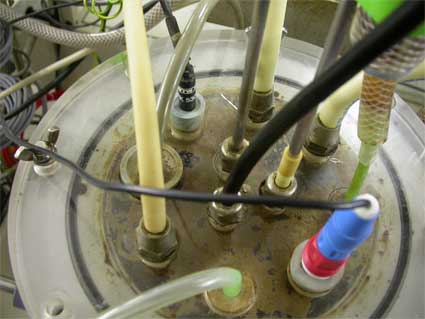
Bioreactor to stabilize urine, photo Eawag
The installation will be on view and the DIY kits will be available at the exhibition FEEDBACK at Eyebeam, March 13 – April 19, 2008.
2. Invisible: Animal Behavior Patterns
Joshua Klein built a vending machine that teaches crows to deposit coins in exchange for peanuts. Crows are surprisingly (for me) intelligent. Their brain/body weight ratios are similar to chimpanzees. Look at the image below, seagulls don’t get the vending machines but those smart little crows seem to understand that there’s something worth their attention there.
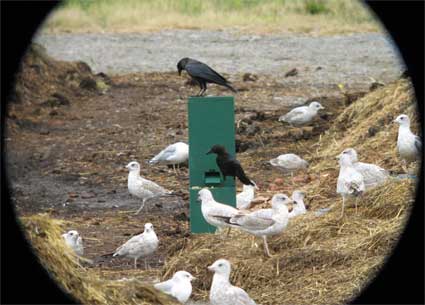
Once he has fine-tuned the vending machine training, his plan is to train crows for search and rescue, picking up trash, and other mutually beneficial tasks (via boing boing). The machine is only the first step in his quest for “interspecies harmony.”
3. Invisible: Social Connections
 Generative Social Networking, by Andrew Schneider and Christian Croft, uncovers the dark sides of social networks by exposing their vulnerability. The software uses bluesnarfing to open the mobile phonebooks of people using security loophole-laden Bluetooth devices. This phonebook data is then fed through the GSN System. Unbeknownst to the phone owner, the device betrays its list of phone numbers to a laptop. An Asterisk phone server will then generate a “conversation” with each number in the list. The first number on the list is called and receiver’s response recorded. The next number on the list is called, the first number’s initial response is played back to the new number, and the new number’s response to the old number’s prompt is recorded. This continues for however many phone numbers are in the contact list.
Generative Social Networking, by Andrew Schneider and Christian Croft, uncovers the dark sides of social networks by exposing their vulnerability. The software uses bluesnarfing to open the mobile phonebooks of people using security loophole-laden Bluetooth devices. This phonebook data is then fed through the GSN System. Unbeknownst to the phone owner, the device betrays its list of phone numbers to a laptop. An Asterisk phone server will then generate a “conversation” with each number in the list. The first number on the list is called and receiver’s response recorded. The next number on the list is called, the first number’s initial response is played back to the new number, and the new number’s response to the old number’s prompt is recorded. This continues for however many phone numbers are in the contact list.
More fun with the video.
In January, i was in Hungary to visit Kitchen Budapest. Before i head to a review of what i’ve seen in the geek alcove, i’m going to list a few surprises i encountered while i was walking through the capital:
I don’t know what is the matter with their public statues but some get tortured with fierce cruelty (must have something to do with the moustache):
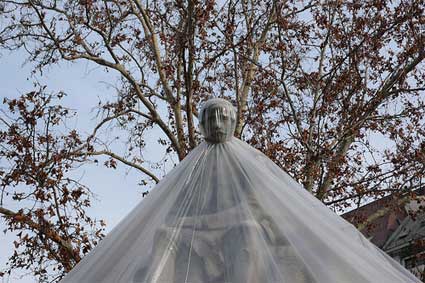
Workers have some really classy hats:
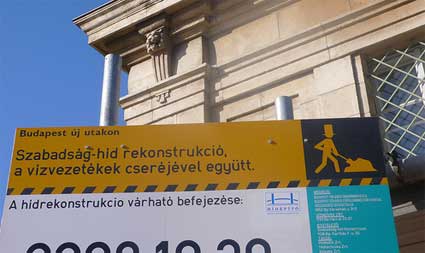
Santa has more fun there than anywhere else in the world
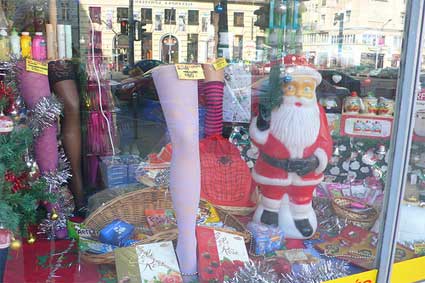
On January 26, the KiBu lab was opening its doors for a Kibu.Projects.Social event to present all Kitchen Budapest projects, get feedback on their work from visitors, drink hot chocolate and end the evening with performances.
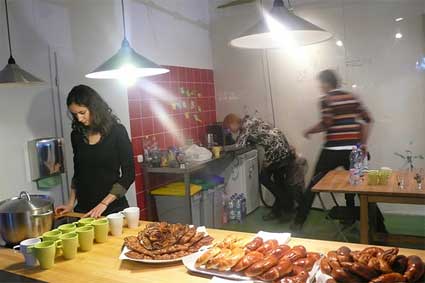
Kitchen Budapest, a new media lab which opened its doors in June 2007, invites researchers, designers and artists to explore the convergence of mobile communication, online communities and urban space but also their impact on our society. Its director is Adam Somlai-Fischer whose work with Aether Architecture you probably know.
Some of the prototypes presented in January were developed over several months, others took only a couple of weeks to form. KiBu is sponsored by a telecom company but that doesn’t mean that its projects stop at the end of the phone antenna: the KiBuists are having fun with blenders, lamps, games, plants, gym, etc.
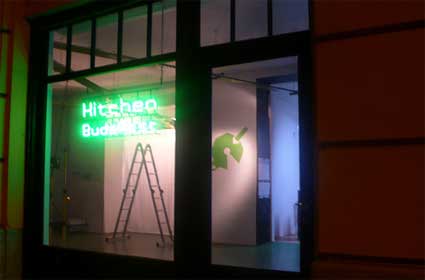
They work in team of people coming from very different backgrounds who mix and teach each other their passion and knowledge.
Now about (some of) the projects:
Eco Gym made me laugh out loud.
First you have this home bicycle which belonged to the mother of one of the KiBu designers. Well, i think that this bicycle is gorgeous, it belongs to a museum. Not that the KiBu people care that much, they simply dragged it to the lab and turned it into an eco-conscious experiment (a bit like Myriel Milicevic‘s Human Powered workshop in Antwerp last year).
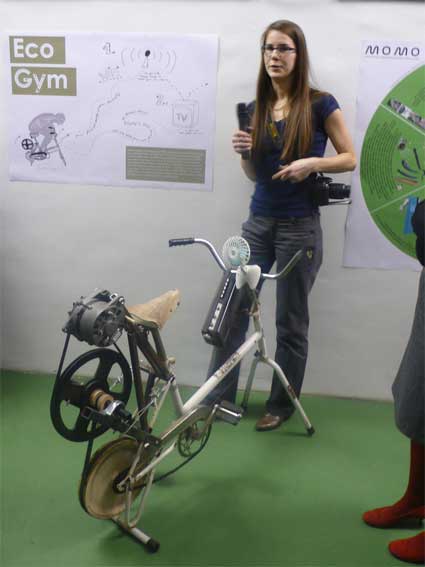
The bicycle is the first prototype of a group of projects which will harvest the energy of its user’s own activity and use it to power the light for example. The idea is to have a whole gym where energy wasting does not exist. The energy of users sweating on a training machine would power the whole gym: light, sound system, air-con, etc.
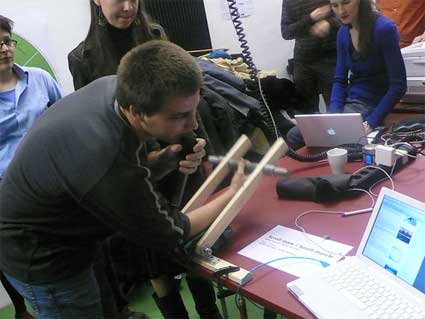
The same team of designers is also working on MOMO, a series of smaller applications which would motivate you to engage in physical activities during your daily routine. They were showing the Scroll-Muscle machine (image above), a system which forces you to flex your arm and exercise your biceps/triceps each time you scroll down a webpage.
Landprint is a really really really nice project I mentioned earlier but i was glad to finally be able to discuss with its designers.
The work is still very much in progress.
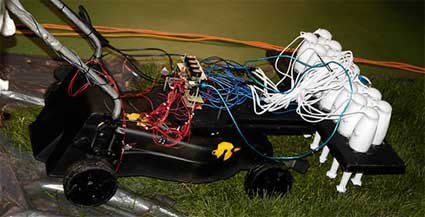
The main idea of Landprint is to develop a program-manipulated plant cultivation system, it would reproduce subtle patterns and photos by combining various species of plants with programmed robotics.
They prototyped an impressive Textmower, a modified lawnmower able to cut a pattern into the grass. While pushing the lawnmower, the robotic device switches on and off small blades as necessary. The final image is made up from the cut and uncut grass surfaces.
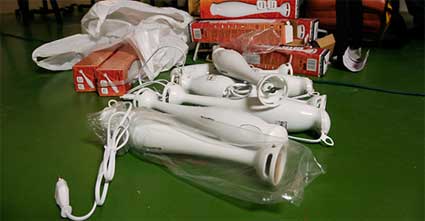
One of their plan is the “Sheep decide”. In this version, instead of a robotic device, it’s a sheep which would make a pattern.
The designers discovered that there are some kind of grass which sheep like and other they do not like. Their plan would be to seed a field with two different hayseeds, the latent picture would emerge and become visible as the sheep eats its way through the field.
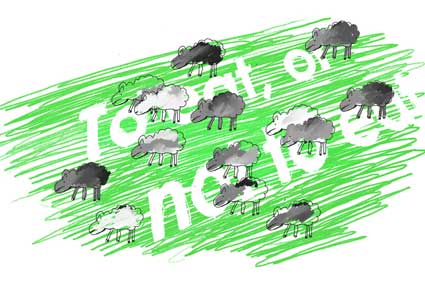
The idea made me think of this video of sheep being “re-programmed” in order to turn grazing animals into self-powered weeding machines.
autoCut is a sound-based “self-editing” video application still in development but already quite impressive. The system would make use of the many short videos shot by mobile devices which usually remain on the hard disk, or are uploaded to a video-sharing portal without any editing.
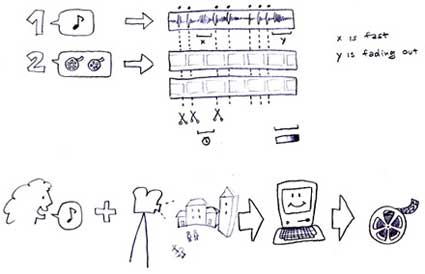
The autoCut program selects and edits the videos according to a certain music. Moreover, autoCut can handle the videos in real time, based on the rythm of live audio input.
this cut-up is made with a pd/pdp prototype, there is no after-editing, it cuts itself based on the beat of the music (crunch). there are 9 small clips, and the program chooses between them, while modifying the clips speed, position, and image composition (rotation).
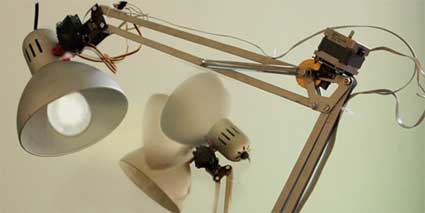
Mllamp was sick while i was in Budapest. The project experiments with emotions simulation and putting minimal intelligence into everyday things. The robotically-enhanced desk lamp has been suited up with anthropomorphous character which induces the audience to see human or pet gestures in the object’s every moves. Mllamp is an experiment for simulating emotions with putting minimal intelligence into everyday things.
Video:
Light Arbour is a lighting system which reproduces natural phenomena of light and provides an alternative and subtle communication facility between places and people. The aim is not to transmit a clear image of the landscape you see to your partner or friend but rather to send them an atmosphere, an ambiance, an impression of the intensity of the light in the mountain or at sun set for example.
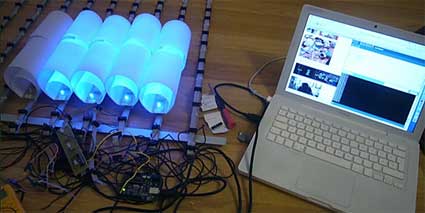
Arbour Light would be supported by a website, which would allow users to upload and use an ambient database made of the videos of Arbour Light owners and “phenomena-collectors”.
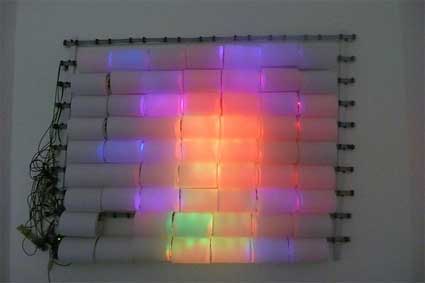
Animata is a real-time animation software for live performance. To create and move virtual characters, you load an image and attach a skeleton to it. By placing them in different depths of field, they get a 3D effect.
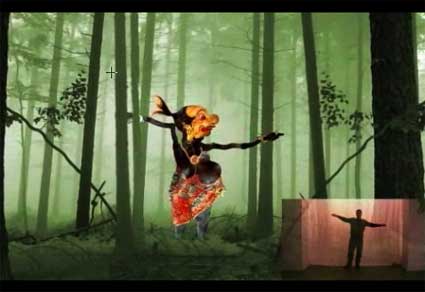
Screenshot from a video showing Reverse Shadow Theatre using Animata
The designers demo’ed the latest version of the project where characters’ movements of a shadow character animation were controlled by the movements of live actors. Furthermore, Animata allows a multi-user collaboration via the internet, thus providing an opportunity for the collective editing and creating of the performance.
Further development include:
– the animation of the characters, camera movement, and other special visual effects will be controllable by cell phones, or through multi-touch-screens or sensors.
– connecting Animata with widespread programming environments (Max/MSP, Pure Data, EyesWeb) to make use of the possibilities of these applications in the fields of image editing, sound analysis, or motion capture.
All the projects.
Image on the homepage by Kitchen Budapest.
Another prototype spotted at the RCA work in progress show a few weeks ago in London. This week: In Memory of the Sparrow
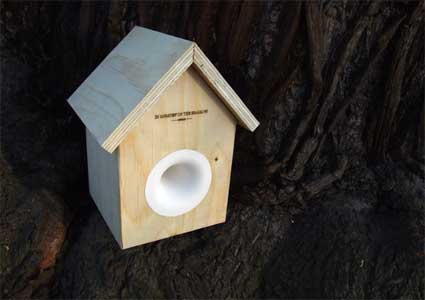
As new wireless technologies are introduced, using various frequencies and power levels, an invisible energy is increasingly altering our habitat. There are no conclusive results from research to indicate the influence of this energy on our health or our environment, but studies have shown that sparrow populations are decreasing in areas that are affected by electromagnetic communication.
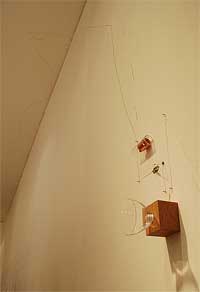
In her scenario, Cathrine Kramer portrays a day when we will walk through a park and meet with an eerie silence. All the birds have disappeared due to an increase of electromagnetic radiation in the urban environment. Inspired by the ‘foxhole radio‘. These simple radios, popular among soldiers during the World War II, need mainly electromagnetic waves as a source of energy.
The object harnesses the very force that drove birds away, and transforms it into subtle bird-like sounds, acting both as a comfort to those who want to remember the sparrows, but also as a poignant reminder that our surroundings contain a level of complexity that surpasses our senses. They are “memorial to the sparrows.”
I asked Cathrine how exactly the bird-like sound was created. “In the exhibition the bird sound was orchestrated, because to work the radio would have to be grounded and this was not possible within the exhibition space,” she explained. “However, in the future scenario I envisioned, these memorials would be mounted to trees and tuned to pick up bird sounds transmitted on an AM frequency bandwidth. The antenna would be a long wire spiraling up the tree to pick up the radio waves.”
All images courtesy of Cathrine Kramer.
Michael Mandiberg and Brooke Singer are two wizards of eco-data visualization.
Eyebeam alum. Brooke Singer is behind Area´s Immediate Reading and the Superfund 365, A Site-A-Day. Superfund 365 is probably my favourite project from 2007. Each day for a year, this online data visualization application visits one toxic site active in the Superfund program run by the U.S. The contaminant, the responsible party and the people involved with or impacted by Superfund are represented in the project.
Michael Mandiberg is a 2007-08 Fellow in the R&D OpenLab and the author of two eye-opening dataviz plug-ins: Oil Standard converts all prices from U.S. Dollars into the equivalent value in barrels of crude oil and Real Costs inserts emissions data into travel related e-commerce websites. Think of it like the nutritional information labeling on the back of food… except for emissions.
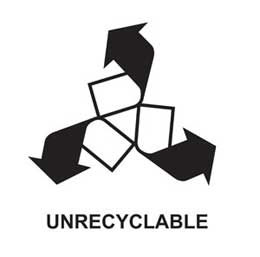 On the left: Grand prize in the Eco-Icons category: Oz Etzioni’s Unrecyclable Icon
On the left: Grand prize in the Eco-Icons category: Oz Etzioni’s Unrecyclable Icon
As members of the Eyebeam Sustainability Research Group (which began in July 2006 as a forum for residents, fellows, and staff to engage in a critical dialog about environmental sustainability) the two of them have launched Eco-Vis Challenge, a competition which was previously mentioned on the blog (Eyebeam’s Ecovisualiz Design Challenge panel, part 1 and part 2).
Based on the idea that being aware of the current environmental crisis doesn’t mean that it is easy to recognize its extent and complexity, the “Eco-Vis Challenge” invited artists and designers to submit projects which make meaningful patterns emerge from the mass of environmental data.
The first challenge asked for new “Eco Icons” that “make visible environmental or ecological concerns”. The second one called for an eco-visualization based on at least one set of the ecological impact data.
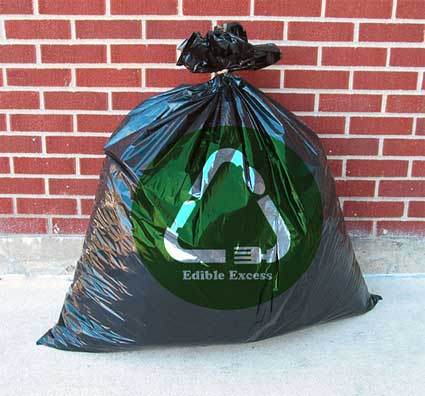
Forays‘ Edible Excess. Honorable Mention in the Eco-Icons category. Courtesy the artist and Eyebeam
The winners of the Eco-Vis Challenge have been announced a few weeks ago and their projects are on view at Eyebeam until the end of the week, as a preview for the March 13 – April 19 Feedback exhibition, which will feature the realized proposals alongside work by past and current Eyebeam artists, with others. Both events are part of Eyebeam’s ongoing Beyond Light Bulbs programming series, which grew from the conversations and findings of Eyebeam’s Sustainability Research Group.
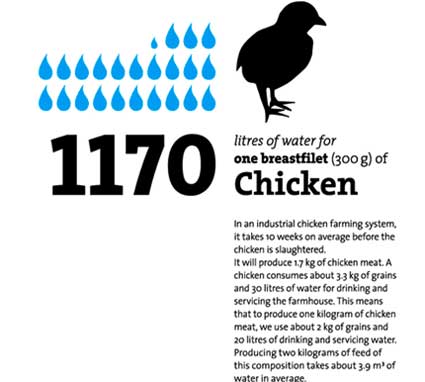
Designer Timm Kekeritz created a poster, visualizing parts of the research data gathered in the research paper Water footprints of nations, to make the issue of virtual water and the water footprint perceptible
If you can’t make it to the exhibition, here’s a link to the winning projects and a couple of questions i asked to Michael Mandiberg and Brooke Singer.
The competition is part of Eyebeam‘s ongoing Beyond Light Bulbs programming series, which grew from the conversations and findings of Eyebeam’s Sustainability Research Group. Can you tell me what is the Sustainability Research Group? What is its origin? Its aim?
BROOKE: There were several artists at Eyebeam in 2006 doing work addressing environmental issues and the Sustainability Research Group was at first casual meetings to meet and share research. Initially the group was Ben Engebreth (Person Kyoto), Michael Mandiberg (Real Costs), Jeff Feddersen (Earth Speaker) and myself (Brooke Singer“>Brooke Singer, member of Preemptive Media, AIR) as well as several Eyebeam staffers (Amanda McDonald Crowley, Paul Amitai, Emma Llyod, Liz Slagus). Over time, as new fellows, residents and commissions entered Eyebeam, the group’s membership expanded and we started thinking about events, actions and programming along with keeping up the discussions.
The ECO VIS Challenge was one of the first events we planned as a group and Beyond Light Bulbs is a larger, more ambitious programming series.
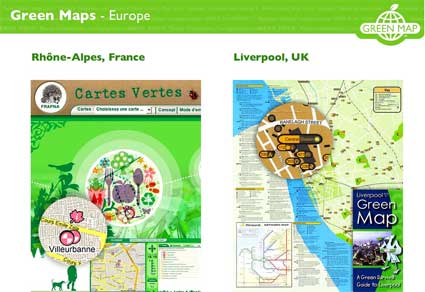
Honorable Mention in the Eco-Icons category: Green Map
Eyebeam has put emphasis on sustainability issues recently, is it something you want to pursue in the long run or just another chapter in the series of eyebeam’s commissions and exhibitions?
BROOKE: I think as artists we see what happens, where our interests lead us, and I am not sure what Eyebeam would answer as an institution. But some of our conversations within the group are about how to make the conversation itself “sustainable” and not just a fad. In the US there was a big environmental movement in the 1970s which we all know of as fact but few of us in the group have firsthand memory of it. For instance, President Carter installed solar panels on the White House roof (last week you mentioned an interesting artist project that goes on a hunt for those very panels which were de-installed in 1980) and today there is such a resurgence of interest in solar. But what happened to solar power for those 25 years? I think many of us are highly skeptical of the current hype and media machine around “green.” We are looking for alternative ways to engage ourselves and the public in the important issues of global warming, toxic dumping, public health, air quality — among others.
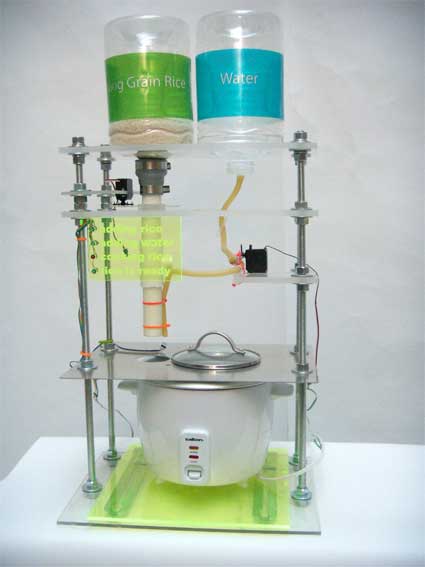
Honorable mention in the Eco-Visualization category, Annina Rüst‘s RiceCooker
The exhibition has been running for a few days now, which kind of public visits it? I’m asking because i assume (maybe wrongly) that you probably have visitors who come mostly from the new media art field and i wonder what the impact of the eco-viz challenge can be outside of its usual circle of converted?
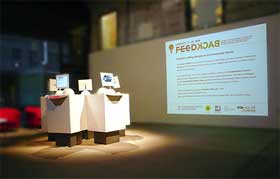 Image: Michael Mandiberg, FEEDBACK preview installation at Eyebeam, 2008
Image: Michael Mandiberg, FEEDBACK preview installation at Eyebeam, 2008
MICHAEL: I see the exhibition from where I work in the R&D Lab, and am fairly frequently speaking with visitors who are lost elsewhere in the building (and trying to find the exhibition.) Two types of people seem to be visiting the exhibition: the Chelsea gallery crawl crowd who come in because Eyebeam is the next space on the South side of 21st past Paula Cooper, and people who have come specifically to see this exhibition (who are more likely to be inside the “circle of the converted.”)
The exhibition is only one part of the overall part of the challenge. When we were conceiving the challenge, we saw the potential for creating an impact at each stage of the process. Just by creating the situation where so many designers and artists created works for the competition, we were able to help direct focus on representations of the many environmental crises. Likewise, we are keen putting these works out into the world (if they were not already.)
Thanks Brooke and Michael!
The projects are on display at Eyebeam until January 26 and will be part of the art and tech center’s upcoming exhibition on sustainable practice: Feedback, March 13 – April 19, 2008.
Images of the entrants to the eco-viz challenge.
Members of the the Sustainability Research Group are currently contributing to Eyebeam’s reBlog website.
Related: Interview with Forays: Geraldine Juárez and Adam Bobbette; Eyebeam’s Ecovisualiz Design Challenge panel (part 1) and (part 2).
Alejandro Tamayo is an artist-engineer and a teacher working in the intersections of design, art and new technologies in Bogota. A year ago, i interviewed Alejandro about the lab he’s currently directing in Bogota.
The v*i*d*a lab, part of the Aesthetics Department at the Javeriana University, is focusing on the development of new design products and ideas. Guided by a reflexion on life itself, the course proposes to engage with organic (biological) and “post-organic” (electronic, digital) visions, trying to identify new relationships and interrogations that could be translated into the realization of concrete projects.

Random Hamster allows pets to participate to card games
I stumbled upon the projects of the latest v*i*d*a lab over the weekend and liked some of them so much that i thought that it wouldn’t hurt to cover some of them on wmmna. Which meant pestering Alejandro with some more questions:
What was the brief you gave to students at the beginning of the workshop? Was there a particular theme to explore?
We don’t start with a particular problem to be solved, instead we always begin with a very broad question: what is life? Students are then encouraged to explore and contrast scientific and mystic approaches. some liked ideas and characteristics derived from considering living organisms as open systems, others reflected about life as a particular organization of matter, others were interested in concepts derived from thermodynamics, cybernetics, etc., while others liked ideas about chance, causality, teleology and so on. After this phase students had to look for ways to apply their findings and interests in their own contexts looking for ways to draw connections to their every day lives. The idea is that they start to confront their “objective” findings with their subjective and personal experience. And this is the way all the projects start to appear. For some it took a long time to come up with something while others found interesting connections easily.
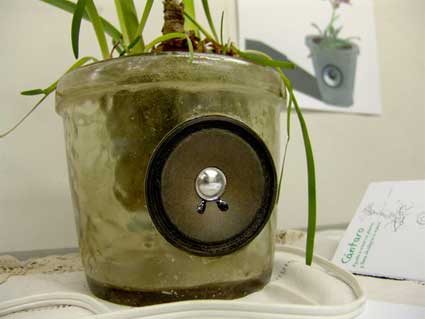
Cántaro, a flower pot that plays music according to the plant conditions
Who are the students? What are they studying and what is their background in electronics (if any)?
They were all students of industrial design and they were in their 7th semester. None of them had a previous knowledge in electronics. We try to make them appropriate very rapidly the basic language needed to understand an electronic diagram, to play with electronic components and sensors, to break them, and to try to overcome the fear of disassembling electronic objects. The also start messing up with microcontrollers (pics and the arduino platform) from very early in the program.
The projects are detailed on a webpage but here are some of my favorites:
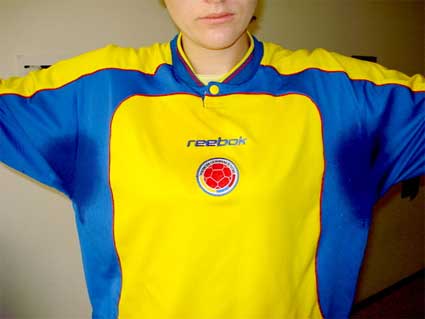
T-shirt that sweats
The T-shirt that sweats, by Mariana Rivera. Sweat, a natural phenomenon present in most forms of life, is usually regarded as unpleasant and something to hide in most western countries and in America especially. There is one exception: futbol (soccer, football) T-shirts. Considered as a fetish object, a sweated T-shirt worn by one’s favorite player is considered of great value.
T-Shirt That Sweats proposes to provide the football supporter –who couldn’t attend the match but follows it from afar, on his or her tv– with a more intimate contact with the action that takes place on the field. The project could thus enrich and expand the communicative power of the tv set through a t-shirt that sweats according to the sound levels of the TV screen during the game.
Working prototype: a microphone captures the sound signals coming from the tv set. The sounds are then filtered using a microcontroller. When the sound goes beyond a certain level, a water pump hidden inside the garment wets the t-shirt. Programmed using Arduino.
The second project i wanted to highlight is less “in your face” but it is also very endearing and fascinating: Cafetera VLF (aka VLF StreamCafe), by Andrés Vargas, refers to 2 projects i liked a lot (although one is much more credible than the other):
– Jean-Pierre Aubé’s VLF Natural Radio which underlines how the growing use of the frequencies necessary for digital and wireless communications is overriding the naturally produced waves of the northern lights and other climate-related signals. According to Aubé, “eventually, VLF waves will be completely drowned out by the signals of various telecommunication systems.”
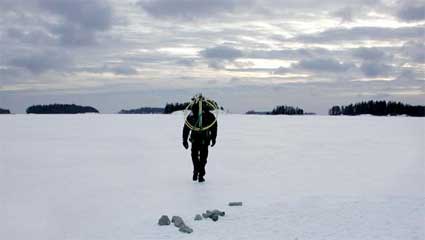
Capture de sons sur la Baltique, Finlande, 2003
– Masaru Emoto‘s theories and experiments on our thoughts, words, ideas and music affect the molecular structure of water. The Japanese researcher claims that if human thoughts are directed at water before it is frozen, images of the resulting water crystals will be beautiful or ugly depending upon whether the thoughts were positive or negative.
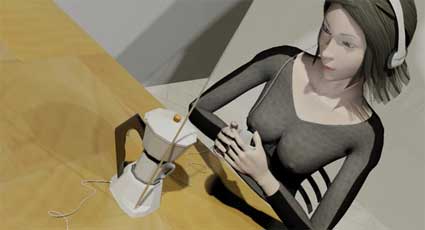
VLF StreamCafe
The earth is constantly emitting a variety of sounds ranged in the VLF spectrum (very low frequency) which are the result of electromagnetic activity taking place in the magnetosphere. Some compare these sounds with spontaneous Earth Songs and we may also interpret them as an evidence of our planet’s activity as a living organism. To listen to these sounds we need a VLF radio receiver (D.I.Y. example by Stephen P. McGreevy). Inspired by this phenomena and by Masaru Emoto‘s research (that reflects about the profound sensibility of water to the subtleties of its surroundings).
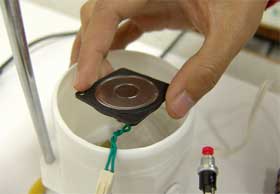
VLF StreamCafe proposes to relate the activity of the planet with daily life gestures (making and drinking coffee), exploring the incorporation of a VLF receiver into a coffee maker, connecting the water we use to prepare coffee with real time Earth Songs.
The concept would thus materialize in a coffee machine able to transmit the emotions, feelings, songs and energy of our planet through the coffee, reminding us of our intimate relationship with the planet we live in. The tiny vibrations generated by the sounds wold be captured by a VLF receptor and transmitted to the water used for the coffee.
In February, the first public exhibition of v*i*d*a* will take place at the Alliance Française, in Bogota. In March, Alejandro will be in Helsinki to give a presentation at the Pixelache festival.
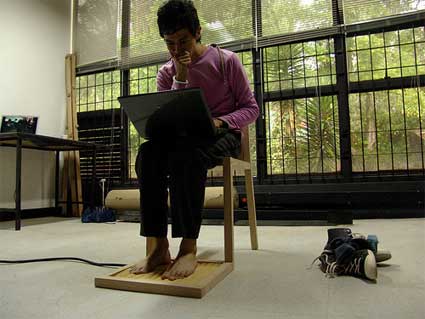
Una Silla, a “placebo’d chair”
Images of the projects, courtesy of Alejandro Tamayo.
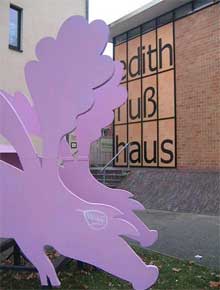 One of my favourite exhibition spaces for new media art is the Edith Russ Haus in Oldenburg (Germany). It’s hell to get there from Berlin. Hell as in 3 different trains and although they are the usual super comfortable kind you expect from the German railway services, it’s still a total of 7 hours spent in stations and wagons for a return trip. But once you’re back from Oldenburg, there isn’t any doubt left: the quality of the show was worth the transport tedium.
One of my favourite exhibition spaces for new media art is the Edith Russ Haus in Oldenburg (Germany). It’s hell to get there from Berlin. Hell as in 3 different trains and although they are the usual super comfortable kind you expect from the German railway services, it’s still a total of 7 hours spent in stations and wagons for a return trip. But once you’re back from Oldenburg, there isn’t any doubt left: the quality of the show was worth the transport tedium.
The current exhibition, Ecomedia – Ecological Strategies in Today’s Art, presents projects founded on progressive ecological models and conceive utopian horizons in the process. It peruses fundamental considerations concerning ecosystems, sustainability, renewable energy sources, as well as visions of the future. In addition, it examines the role of art and new media over and above science, technology, and ecoactivism. I liked the theme, the way the curators explored it but most of all i found that the works on show were of particularly good quality, individually and as a whole.
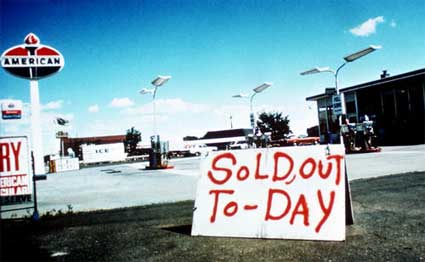
1973 oil crisis
The work that moved me the most is Christina Hemauer’s and Roman Keller’s video and installation work, A Moral Equivalent of War: A Curiosity, a Museum Piece and an Example of a Road not Taken (2006-7). Reading news headlines yesterday, i realized how meaningful the work is. The title of the work, inspired by a television speech to the Nation delivered by Jimmy Carter in 1977, documents the artists’ quest for the solar panels that President Carter had mounted on the roof of the West Wing of the White House in 1979 during a moment of awareness of the dangers of the US’ dependence on foreign oil.
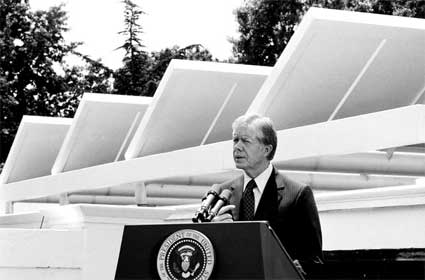
Dedication of the solar panels
In 1977 Carter convinced the Democratic Congress to create the US Department of Energy. Promoting the department’s recommendation to conserve energy, Carter wore sweaters, had solar panels installed on the roof of the White House, had a wood stove in his living quarters, and requested that Christmas decorations remain dark in 1979 and 1980.
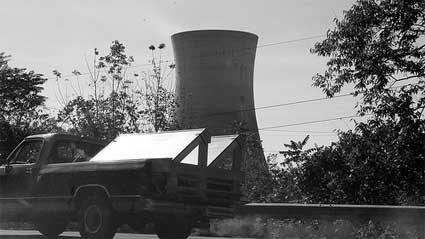
Christina Hemauer/Roman Keller: A Moral Equivalent of War, 2007. Image courtesy of Edith Russ Haus
In 1991, «America’s Environmental College», Unity College in Maine, tracked the panels, found them in a warehouse just outside DC, bought them for peanuts and installed them on the roof of their dining room. Hemauer and Keller strapped one of the panels to the roof of their car and drove from Maine to the Jimmy Carter Library and Museum in Atlanta, filming a documentary along the way, interviewing people who had been involved in the solar panel experiment, and reopening a dialogue about present energy policy.
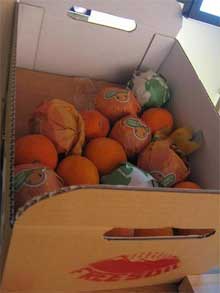 Just like A Moral Equivalent of War, The Acorn Pig Cinema, MILKproject and F.R.U.I.T. are projects which slap you in the face with all their relevance.
Just like A Moral Equivalent of War, The Acorn Pig Cinema, MILKproject and F.R.U.I.T. are projects which slap you in the face with all their relevance.
We keep reading that eating local food might not always be such a good idea. Sometimes the food is sent on huge globetrotting journeys whether the reason for the trip is that english prawns are cheaper when shelled in Asia or that lamb is four times more energy-efficient when imported from the other side of the world than when it is bought from a producer in your backyard. Eating local can have damaging effects on African organic farmers. You can’t make feta in Yorkshire and we should all start thinking about adopting a vegetable.
FRUIT, by Free Soil, invites visitors to take their ecological knowledge into their own hands, by becoming aware of the entire life of a product, from production to utilization, and not just what they see in the stores. Consumers must be aware that every phase of a product’s life influences the environment and ourselves. F.R.U.I.T wrappers, a website, and a traveling installation are part of an initiative to inform people about alternative food systems and local food movements.
Free Soil uses oranges as a vehicle to explore the complex relationships that make up the worlds Food Systems. The oranges –that Free Soil found at the Oldenburg local distributor– in Winter come from South Africa. This means that they have been underway at least one month by boat. This is also why it is practically impossible to have organic oranges at this time of year as most of them would rot if they were not treated chemically.
MILK, a project by Esther Polak, Ieva Auzina and Rixc, follows the milk from the cow to the table of the consumer. All the participants, from Latvian farmers to Dutch cheese makers and market salesmen, were given a GPS device for one of the days that saw them involved in the movements of the dairy product.
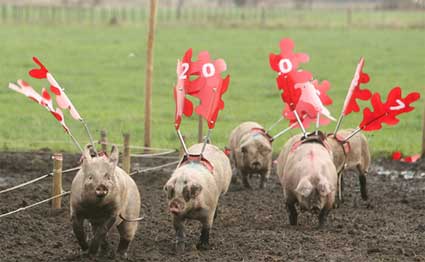
Insa Winkler: Das Eichelschwein Kino Mobil. Image courtesy of Edith Russ Haus
Insa Winkler‘s work intends to make us reflect on the globally implemented industrial farming.
In a mass production factory located Wülknitz, a municipality in Saxony (Germany), pigs destined to become Tyrolean bacon are fattened. Wülknitz is situated in a highly exploited mono-cultivated land and suffers greatly from an exodus of the population.
How is it that the famous Tyrolean bacon can make its name by means of anonymous pigs from Saxony? If these pigs can be made into Tyrolean bacon, then it should also be possible to produce a speciality of equal quality – the “Saxon acorn ham†– in a setting which is worth living in for both man and animal in compliance with the premises of the Agenda 21.
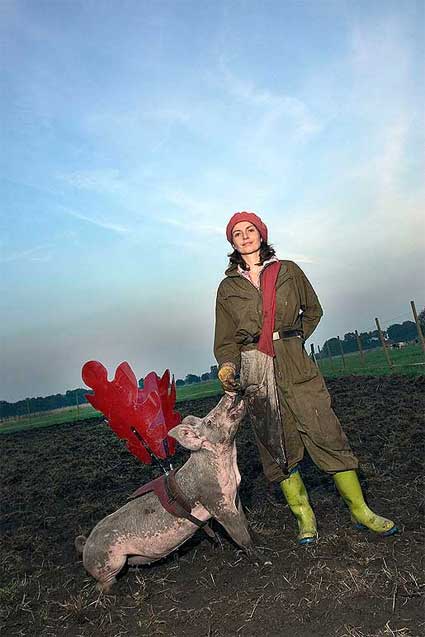
Insa Winkler interviewed farmers of conventional pig farming, studied the mechanisms of industrial meat production, the destruction of landscape with monoculture and fields for liquid manure, etc. She searched a piece of land around Wülknitz, got authorization to keep pigs outside, bought a special breed of pigs and learned how to raise and feed them on acorns. The ham from these pigs will be produced in a local factory, and then sold in local restaurants, throughout Germany and also internationally.
Raising piglets in acorn forests – like some parts of Spain still do today – is not just a romantic ideal, it can also be an important contribution for the biodiversity of landscape.
Insa Winkler created a logo and a public relation vehicle for her project: The Acorn Pig Cinema which transports the film from the Project since 2004.
Parallel to a public discussion, the practicality of The Acorn Pig as an agricultural project is explored, making it both an agricultural and a cultural experiment.
But what if we should keep on breeding, feeding and killing pigs industrially? Is there a way to keep the animal welfare element in the equation? Rotterdam architecture office MVRDV thinks so. The Pig City project, for which they collaborated with the Dutch Ministry of Agriculture, Nature and Fisheries, is a computer simulation of skyscrapers for industrial pig breeding.
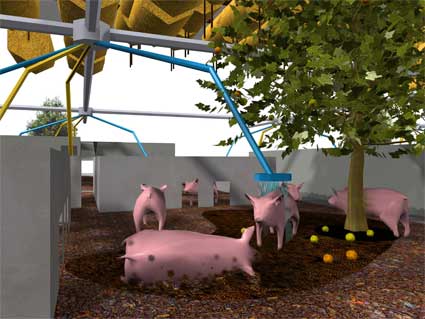
MVRDV: Pig City, 2000-2001. Image courtesy of Edith Russ Haus
Pigs would inhabit stacked ‘apartments’, balconies would allow them to rummage around under trees outside. Pigs for slaughter would be moved in lifts and brought to a central abattoir housed in the plinth. On top, a fish farm would supply some of the food needed. Each tower contains a central slurry-processing plant and a biogas tank, which caters for the tower’s energy needs. To reduce transport costs, towers are located either in the port or close to major cities.
When first presented the project met with heavy discussions: criticism centred on the dangers of centralisation. Should one element be put out of operation, then the consequences for the whole system couldn’t be foreseen. There were also unfavourable comments about the belief that society can reduce nature into models that are then turned into reality. What is more, the pig flats would ‘harm’ the image of the pig-farming sector. Architecture critics in the media were much more receptive and viewed it as a courageous proposal.
Ecological Strategies in Today’s Art runs until January 13 at the ERH in Oldenburg, Germany.
Set of images.
Previous exhibition at the Edith Russ Haus: Soundbytes (part 1 and 2).
Related stories: Edible City, Part 1 and 2. Eyebeam’s Ecoviz Design Challenge panel (part 1), Eyebeam’s Ecoviz Design Challenge panel (part 2).